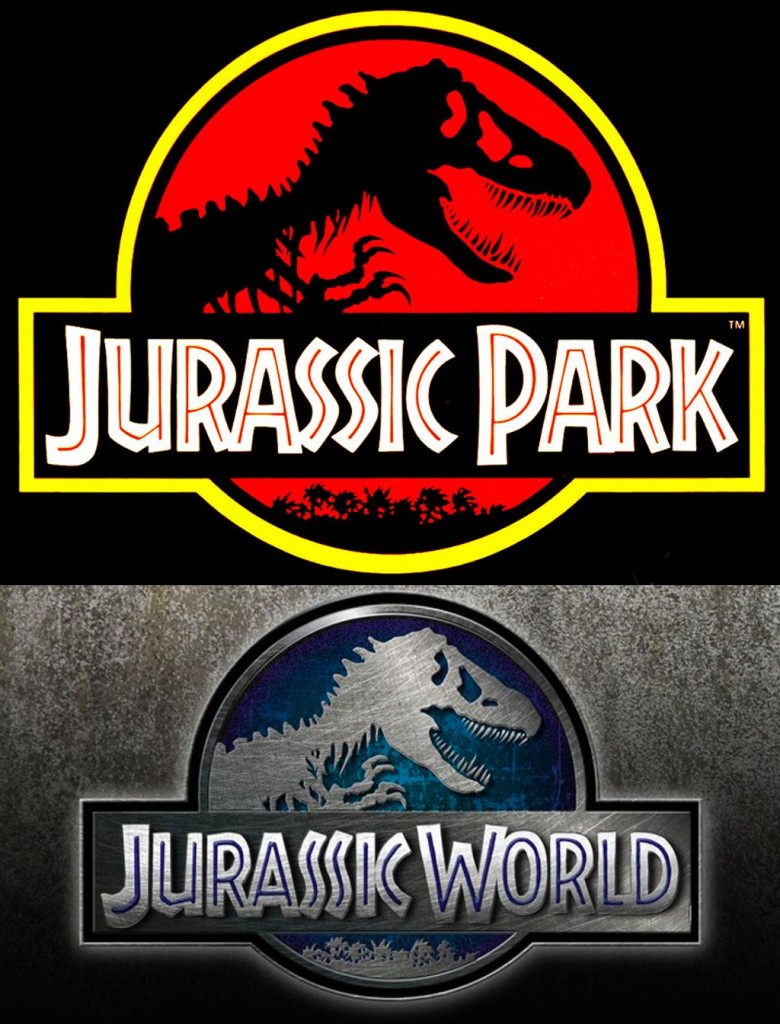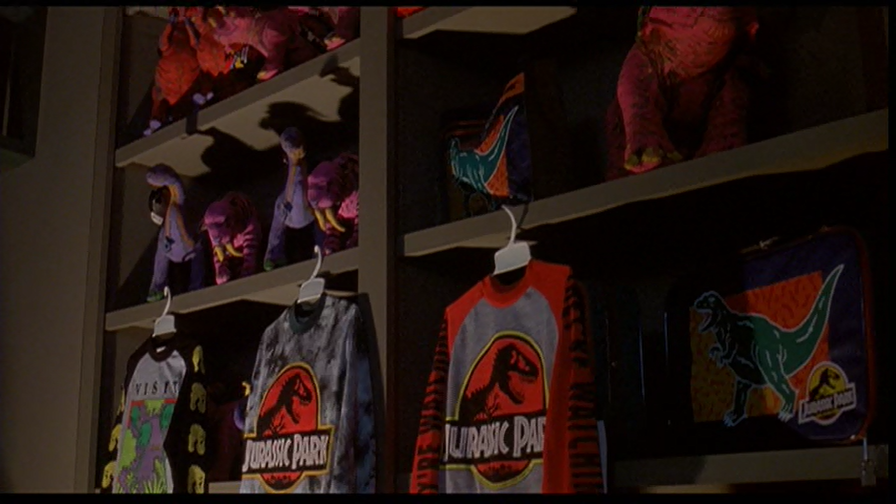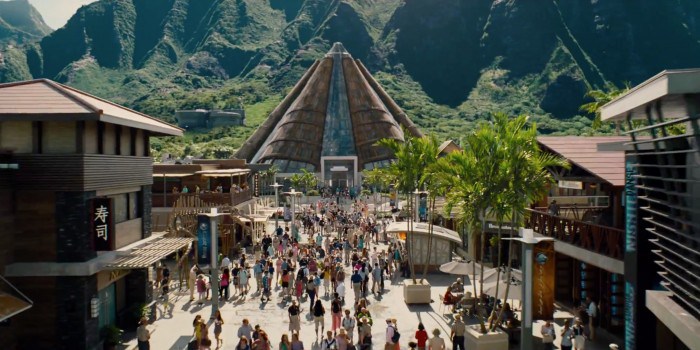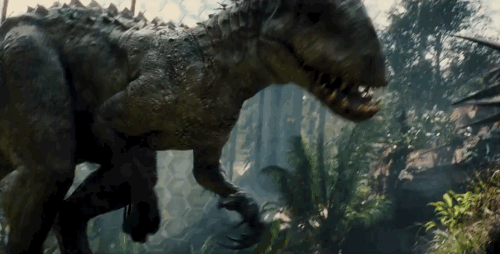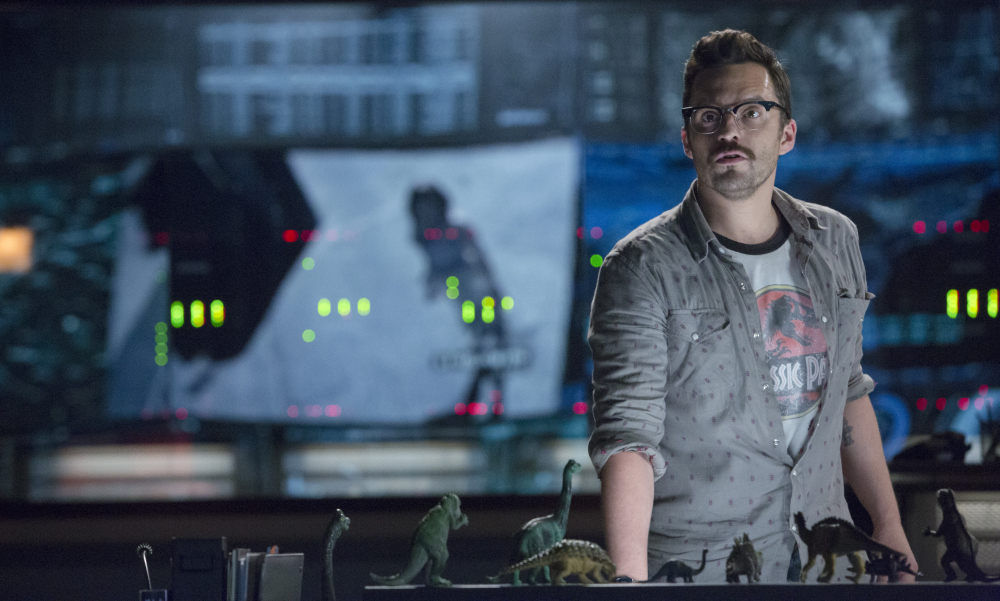I saw Jurassic World twice over the last week. At first blush, my thought was that it was an extremely enjoyable blockbuster that really shines despite pretty flat characters and a perfunctory plot. But something about the visual sense of movie really stuck with me. After another viewing, the movie’s underlying intelligence became much clearer. It’s pretty transparent that Colin Trevorrow’s film was made with love and reverence for the original Jurassic Park, and this is a movie about that movie in some unexpected ways. Jurassic World communicates some of Trevorrow’s larger ideas almost solely through visuals.
To really unpack this, we have to start with Jurassic Park, and, if we’re starting there, we have to talk about the logo. Chip Kidd’s ubiquitous T. Rex skeleton design is iconic, perfectly communicating some subtle menace behind a logo you can slap on nearly everything. In the original film, this logo can be seen throughout the entire park, on everything from lunch boxes to Jeeps. We all know the Jurassic Park logo because the film never lets us forget it.
Beyond the logo itself, there’s a very specific and calculated color scheme followed by the park seen in the original film: vivid, bright reds, yellows, and greens. We see it on the track vehicle Alan Grant and company take in their initial expedition, and later on in the “Gallimimus Gift Shop” and the Visitor Center. It’s warm, and it’s exciting.
The park’s creator, Richard Attenborrough’s kindly John Hammond, designed the park as an attraction for children. His love of showmanship is both implied (the incredibly theatrical park orientation he submits his guests to) and told to us directly (a line of dialogue describing his days as a street performer in London). The look of the park is certainly reflective of Hammond himself as well as something of a visual gag, given the horror that follows once the park’s security measures go offline. Even though his dream is ultimately shortsighted and disastrously untenable, Hammond’s vision for Jurassic Park is well-intentioned; he wants to create something for the benefit of mankind. When company lawyer Gennaro suggests price gouging visitors to the park, Hammond is disgusted.
Flash to the present day. It’s 22 years later. Jurassic World, both the theme park island and the film itself, utilizes a strikingly different color scheme of cobalt blue and chrome steel. The attractive color scheme that’s tied in our minds to the original park has been replaced with a sleeker, more overtly corporate look. There’s a sense of something being off here, by design.
Taking this a step further, lets look at each film’s respective “wow” scene. In Jurassic Park, our characters aren’t impressed until they’re taken to a majestic Brontosaurus as it grazes. John Williams’ signature score swells. The normally reserved Alan Grant is overwhelmed with joy at the sight of the unimaginable. “It’s a dinosaur!” he exclaims. When we talk about Jurassic Park, chances are this is the scene you’re thinking of.
Jurassic World has its own perverse version of this scene. As Ty Simpkins’s Gray races through his hotel room and pulls open the doors of his balcony, the classic theme plays over a stunning view of the new park … without a single dinosaur in sight. Jurassic World is the foremost attraction, with dinosaurs a secondary consideration. As Gray and his brother enter the park, there’s signage for massages, tennis and gourmet cuisine. Jurassic World’s equivalent of Main Street U.S.A. boasts a Starbucks, a Brookstone, several restaurants, and even an Isla Nublar Margaritaville. It’s easy to write this all off as product placement (it is), but all of this drives home that Jurassic World is as much a perversion of John Hammond’s dream as it is a successful realization. If the horror of Spielberg’s original film is the threat posed by Hammond’s potential park, Trevorrow’s film is forcing us to look at the souless delivery of that promise.
The operational Jurassic World’s disturbing lack of values is best exemplified by the Indominus Rex. At first, it appears the iRex is dinosaur-as-consumer product: a custom-designed animal made to excite visitors with an array of special abilities (including raptor DNA). When we’re first introduced to it, Bryce Dallas Howard’s park runner Claire has even arranged for the attraction to be underwritten by a real life telecom conglomerate. It’s living spectacle, our collective demand for “more” made manifest and brought to you by Verizon Wireless. Later, we discover the Indominus’ true purpose: a prototype for a living weapon to be deployed on our enemies abroad. While the dinosaurs of Jurassic Park were meant to educate and awe mankind, the Indominus Rex was designed almost exclusively for the purposes of death and war.
Jurassic World‘s explicit references to the original film/park are slowly teased out over the course of the film. Control center operator Lowery (The New Girl‘s Jake Johnson) defiantly wears an original Jurassic Park t-shirt he bought at a premium off eBay. When he’s chastised for it by Claire, he launches into a tirade about how cool the original park’s dinosaurs were and bemoaning the highly corporate, genetic engineering-heavy Jurassic World. As if we weren’t clear on Lowery’s affiliation with the iconography of the original film, a copy of Ian Malcolm’s book rests on his desk.
Later in the film, siblings Zach and Gray discover the ruins of the original Jurassic Park visitor center and manage to jump start one of the older model jeeps. The logic of this scene is pretty shaky, but as a metaphor it’s not hard to see what Trevorrow is going for. Jurassic Park is the salvation of our young heroes.
The movie’s meta-conflict between Jurassic World and Jurassic Park pays off in the film’s conclusion. Jurassic World’s champion, the Indominus Rex, faces off against not just a T. Rex, but the original T. Rex from the first film. This is communicated through her advanced age and visible raptor claw scars. The T. Rex, with the aid of semi-domesticated raptor Blue and a CGI punchline Mosasaurus, is able to kill the albino abomination that is the iRex. The film’s final shot isn’t of our human cast, but of the T. Rex triumphant in her kingdom.
Jurassic World is not just a self-aware sequel; it’s arguably one at odds with itself.

